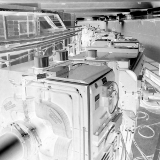Speaker
Sebastian Wolf
(Johannes Gutenberg-Univesity Mainz)
Description
We aim for free-fall experiments with antimatter atoms to determine its acceleration in the earth gravitational field. In such drop experiments and with drop heights below 1 m a temperature of a few µK is crucial to achieve the targeted accuracy of $\Delta g / g$ at the sub-percent level.
The GBAR-collaboration will use positively charged anti-Hydrogen ions ($p^- + 2e^+$) formed at the ELENA facility at CERN, which are captured, and trapped in a Paul trap in combination with Beryllium matter ions [1]. After sympathetic Laser cooling to the motional ground state a photo-detachment pulse generates neutral anti-Hydrogen and starts the drop experiment. The detection is accomplished from the annihilation once the anti-Hydrogen reaches the wall of the UHV system.
In the actual experiments, we establish sympathetic cooling for large mass ratio differences with 40-Calcium and 9-Beryllium ions. In the talk, we show results of the side-band cooling with single Calcium ions and ion crystals. A new trap design using electro-plated electrodes promises extremely low motional heating rates. This is a key for an optimized adiabatic expansion [2] of the axial potential which will be used to reduce the ion momentum distribution, thus improving the measurement accuracy of $g$. We discuss the ionization and cooling laser setup for Beryllium ions to realize mixed crystals of Calcium and Beryllium, and Beryllium and anti-Hydrogen in the later run. Actually, the observation of interference patterns in the far field of an ion crystal allows for a determination of the motional wave packet size [3]. We present schemes for cooling of mixed two-ion crystals with large mass-to-charge-ratio difference, improving the coupling of motional modes [4,5]. Experiments will be performed at ultra-high vacuum conditions in a cryogenic trap setup.
[1] Perez and Saquin, Class. Qantum Grav. 29, 184008 (2012).
[2] G. Poulsen et al., Phys. Rev. A 86, 051402(R) (2012).
[3] U. Eichmann et al., Phys. Rev. Lett. 70, 2359 (1993).
[4] D. J. Gorman et al., Phys. Rev. A 89, 062332 (2014).
[5] J. B. Wübbena et al., Phys. Rev. A 85, 043412 (2012).
Authors
Ferdinand Schmidt-Kaler
Sebastian Wolf
(Johannes Gutenberg-Univesity Mainz)
